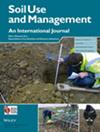Long-term tillage impact on soil phosphorus under different crop sequences
IF 3.7
3区 农林科学
Q1 SOIL SCIENCE
引用次数: 0
Abstract
Management practices, such as tillage and cropping diversification, influence soil phosphorus (P) dynamics. The aim was to evaluate the long-term effect of tillage systems (no tillage, NT; vertical tillage, VT; conventional tillage, CT) on total (TP) and extractable (Pe) soil P distribution under different crop sequences (corn–wheat/soybean, C–W/S; wheat/soybean, W/S; corn–corn, C–C; soybean–soybean, S–S). TP and Pe were measured up to 50 cm deep. The TP distribution was associated to soil organic carbon (SOC) (r = .89, p < .01) and tend to increase near soil surface under NT as compared with CT and VT. The Pe was sensitive to the crop residues pattern of accumulation and their quality in the topsoil. Crop sequences that included corn had lower Pe concentration under NT. Conversely, in W/S, Pe concentration was lower under VT with no differences between NT and CT and, in S–S sequence, there were no differences in Pe concentration. However, under NT the increase in the above-ground biomass in sequences without corn (p < .001) increased Pe concentration in 0–5 cm layer, while the opposite occurs in sequences with corn (p < .06). In S–S under NT, the low crop residue input (1.6 Mg of dry matter ha−1) and the high Pe concentration in 0–5 cm layer (40 mg kg−1) might increase the risk of P loss to adjacent ecosystems. Intensified sequences presented more negative P balances than corn/soybean monoculture. This study demonstrates that it's necessary to develop management strategies that improve P supply in synchrony with the crop demand and decrease P loss, while keeping productivity.不同作物序列下长期耕作对土壤磷的影响
耕作和作物多样化等管理方法会影响土壤磷(P)的动态变化。研究旨在评估不同作物序列(玉米-小麦-大豆,C-W/S;小麦-大豆,W/S;玉米-玉米,C-C;大豆-大豆,S-S)下耕作制度(免耕,NT;垂直耕作,VT;常规耕作,CT)对土壤总磷(TP)和可提取磷(Pe)分布的长期影响。TP 和 Pe 的测量深度达 50 厘米。TP 分布与土壤有机碳 (SOC) 相关(r = .89, p <.01),与 CT 和 VT 相比,在 NT 条件下,TP 在土壤表层附近呈上升趋势。Pe对表土中作物残留物的积累模式及其质量很敏感。包括玉米在内的作物序列在氮下的豌豆含量较低。相反,在 W/S 顺序中,VT 下的豌豆钾浓度较低,而 NT 和 CT 下的豌豆钾浓度没有差异;在 S-S 顺序中,豌豆钾浓度也没有差异。然而,NT 条件下,在没有玉米的序列中,地上生物量的增加(p < .001)提高了 0-5 厘米层的豌豆苷浓度,而在有玉米的序列中则相反(p < .06)。在NT条件下的S-S中,低作物残留物投入量(160万克干物质公顷-1)和0-5厘米土层中的高Pe浓度(40毫克-千克-1)可能会增加邻近生态系统的P流失风险。与玉米/大豆单作相比,强化序列呈现出更多的钾负平衡。这项研究表明,有必要制定管理策略,在保持生产率的同时,根据作物需求同步改善钾的供应,减少钾的流失。
本文章由计算机程序翻译,如有差异,请以英文原文为准。
求助全文
约1分钟内获得全文
求助全文
来源期刊

Soil Use and Management
农林科学-土壤科学
CiteScore
7.70
自引率
13.20%
发文量
78
审稿时长
3 months
期刊介绍:
Soil Use and Management publishes in soil science, earth and environmental science, agricultural science, and engineering fields. The submitted papers should consider the underlying mechanisms governing the natural and anthropogenic processes which affect soil systems, and should inform policy makers and/or practitioners on the sustainable use and management of soil resources. Interdisciplinary studies, e.g. linking soil with climate change, biodiversity, global health, and the UN’s sustainable development goals, with strong novelty, wide implications, and unexpected outcomes are welcomed.
 求助内容:
求助内容: 应助结果提醒方式:
应助结果提醒方式:


